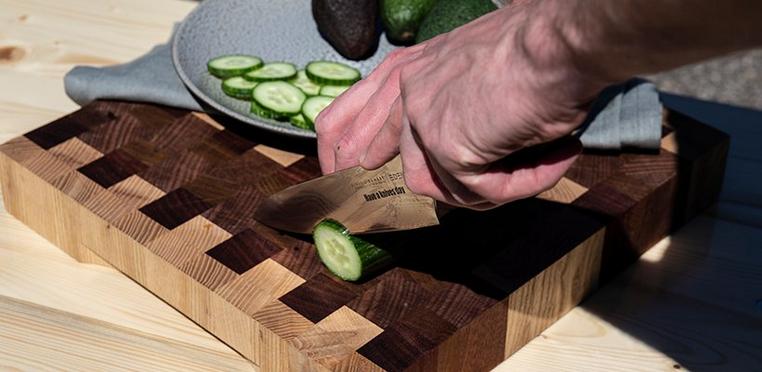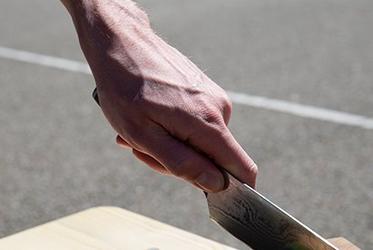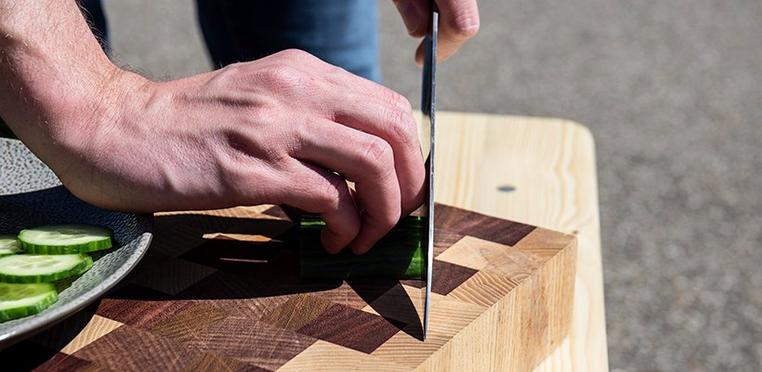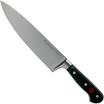Five tips to safely and efficiently use a chef’s knife
Chef’s knives come in many different shapes and sizes and with different prices. From completely smooth blades to knives with cut-outs in the blade and from approximately 16 centimeters in length to more than 30. If you want to be like a professional chef finding the right chef’s knife is essential. Owning the right tools will get you a long way. But not nearly enough as a good knife will only work if you control the required cutting techniques.
Many amateur chefs are to some extent afraid of their chef’s knife. We understand, especially because we know how sharp a good knife can be. However, if you control your knife this is not necessary. By paying attention to the technique it will almost be impossible to cut yourself. For that reason we will give you five practical tips to cut like a real pro!
Tip 1: The right grip
Although there is no such thing as the ‘the best way’ to hold a chef’s knife, there is definitely something you shouldn’t do. Never place your index finger on top of the blade while you use it. You will quickly notice that it is a cramped way of working and that you will soon grow tired. In addition, there is a chance that while you use the knife your index finger will slip and end up underneath the blade. Ouch!
The grip most commonly used is the so-called ‘hammer grip’. You clamp the handle with four fingers and place your thumb against your index finger, at the front of the handle. A version of this grip is called the ‘blade grip’ where the last three fingers clamp the handle while the thumb and index finger lean against the blade. To make sure you don’t cut yourself you should always keep your index finger bent. Fans of this grip – which is less common than the hammer grip – claim they can control the knife better holding it that way.
Tip 2: Use both hands
Perhaps as important as the cutting hand is the guiding hand. After all, this hand determines the tempo and the thickness of the slices. With this ‘free hand’ you can control the hand that is holding the knife. You do so by placing the three middle fingers on top of the product that needs to be sliced. Keep your fingertips bent inwards to make sure only your knuckles can come into contact with the blade of the knife. After all, with it you determine the tempo and it also become impossible to cut yourself (as long as you keep the knife straight).
Tip 3: Keep in contact with the cutting board
On to the cutting itself. It is key that your knife will always stay in contact with the cutting board. You don’t have to lift the knife. After all, you cut with a chef’s knife, you don’t chop with it. When you use it, it should always remain in place. You only move the product with your free hand.
You do so with your pink and thumb, which you keep behind the three slightly bent middle fingers. You place the tip of the knife on the cutting board, in front of the product that needs to be cut. You lift the back of the knife, after which you slide the product underneath the knife. Place the edge on the product and hold the knuckles of your guiding hand against the blade. Now you need to make rocking movements, during which the tip of the knife never leaves the cutting board. The speed used to move your guiding hand back determines how quickly you cut and how thick the slices will be. The video below explains this technique.
Tip 4: Be patient
Yes, we know they look pretty impressive, those television chefs who rapidly move over a cutting board. And after some practice you might be able to do the same thing. But especially in the beginning it is key to take your time. Stop in between to reposition your hand. This will leave you with the best results and it is also safer.
Tip 5: Use a sharp knife
Perhaps obvious, but using a sharp knife is essential. Blunt knives are, after all, more dangerous than razor-sharp ones. You will have to apply more force and the chance that your knife will slide off the product is a lot bigger. The result: you will cut yourself with the knife which will cause a lot more damage than when the same happens and you use a sharp knife.





















